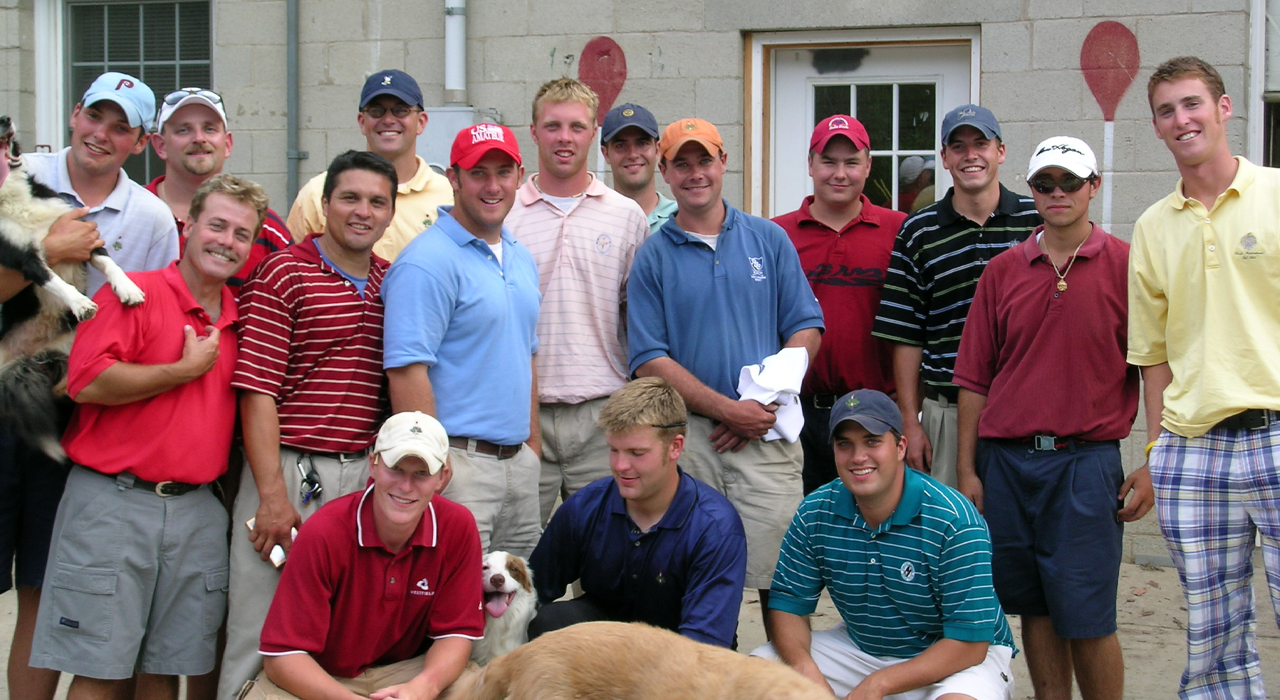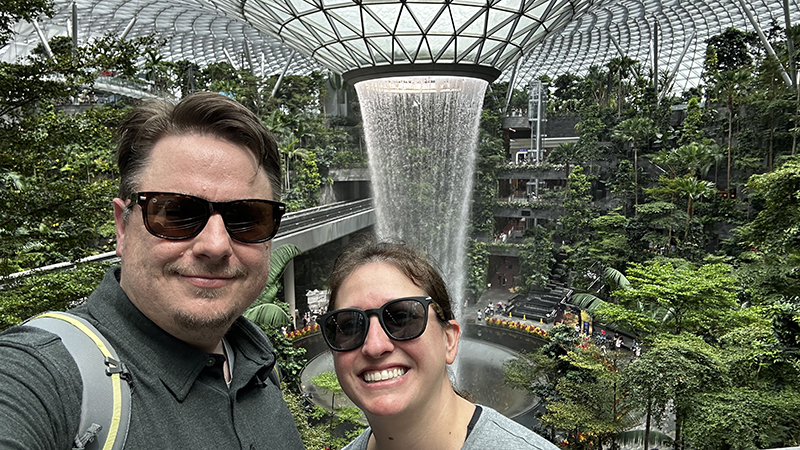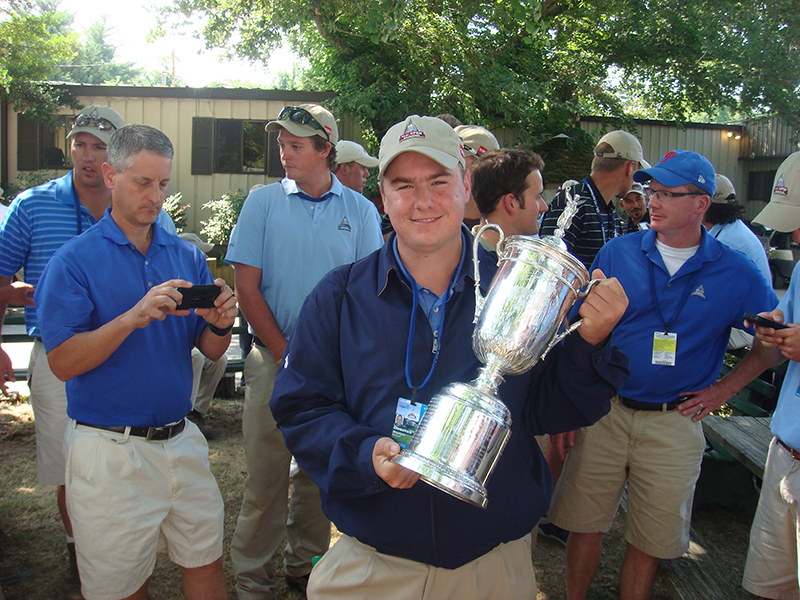Donovan Maguigan used an eye for photography and a passion for turf to get involved and take a leadership role in his local associations. How does he think others can do the same and make a difference? Read on…
By Pat Jones
When you spend your formative years bouncing around from Ohio to Delaware to Singapore, losing track of the things you value most might be easy. But for Donovan Maguigan, he was always anchored by two things: “When I look back at my younger years, there were two things that defined me: I was an Eagle Scout, and I played a lot of golf.”
Today, those two pursuits still impact his life as the golf course superintendent at Springdale Golf Course, a William Flynn treasure in Princeton, N.J. They’ve also helped him emerge as one of his region’s most effective leaders.
When I last saw him in person at the New Jersey Green Expo in 2022, Maguigan was on stage to receive two major awards for his work on behalf of his chapter and his turf association. The recognition was well-earned: at a relatively young age, he had already made his mark on his profession. He established himself as a trusted and thoughtful volunteer in his professional groups.
Maguigan learned to love the game from his dad, who worked for the DuPont Company in Wilmington. He fell in love with classic golf architecture along the way and headed to Ohio State with visions of being the next Ross or Mackenzie. “I naively thought I could just go to school and instantly become a golf course architect,” he says.
He spent summers in Delaware working for the legendary John Gosselin, who was superintendent at DuPont CC then. That opened his eyes to the turf world and led him to Dr. Karl Danneberger and a switch to the turfgrass program at OSU. A summer of interning at Merion GC in 2004 cemented that choice. “I was really green when I was there. I spent years apologizing to Matt Shaffer.” He also met lifelong friends, including Scott Bordner, Mike Dachowski, John Kelly, Andrew Hannah, and Jason Harrison.
Why does he do it? “I liked the daily tangible results. I try to instill in my staff that, at the end of the day, you can look back and see a fairway you mowed or something you improved and get that immediate gratification. There’s not a lot of jobs where you can walk away at the end of the day and look back and say, ‘I did that.'”
He says a golf pro once told him that “every day is somebody’s U.S. Open,” and he tries to cultivate that attitude in his staff, telling them: “You’re going to have an impact on every person who plays the golf course today. It makes an impact on their lives. We’re not curing cancer or putting men on the moon, but we’re making an impact on people’s lives by giving them a gift of golf. At Troon, we talk about ‘creating the experience,’ and I preach that to my people.”
Here’s my conversation with Maguigan about his career and his thoughts on the value of involvement.
How did you get involved in the larger community of superintendents?
Being at Seaview and being so close to the annual New Jersey show in Atlantic City probably got it started. We hosted the ShopRite LPGA, and working with all the volunteers helped me get to know many people from around the state. It was neat because we learned from each other. I met a lot of guys who are my best friends now.
The emergence of social media through Instagram and Twitter really connected a lot of us. I’m more of an Instagram person than a Twitter person. I’d go to the New Jersey show, and people I’d never met had seen my posts or photos. But because of social, people knew me as a guy who maintained turf, drank beer, and ran a lot. It broke the ice and helped me overcome being a bit of an introvert. I’m going to the GCSAA show now, and it’s the same thing. It bridges a lot of gaps between us as turf pros.
I got to know you for that very reason. Your Instagram photography was excellent, and that really stood out to me. How has it been important in your career?
It’s been huge. I can look back at my Google photos all the way back to when I was working on a crew. Once, I stopped and took kind of clandestine pics of Merion in 2004 with a big old digital camera. Ever since, I’ve always had a camera with me and taken a lot of photographs. I’m the poster boy for big digital photo storage plans.
It was getting an iPhone that changed everything. Suddenly, I could take a good picture, tweak them fairly quickly, and do something with them. I didn’t know a lot about the technical side of taking photos, but I have sort of a photographic way of looking at things. I wrote my “Turfheads Take Over” article in GCI magazine about that. Social media helped hone that craft. People like you encouraged me and drove me to continue taking photos. I still take a ton of pictures every day.
What led you to get more involved in the organizations?
Dennis DeSanctis had seen my pictures and social posts and asked me to get involved with the NJTA to help them get started on social media. They offered me a chance to get on their board and focus on communications and social media. That was kind of the foot in the door for me.
People don’t realize how much effort and work it takes to manage that social stuff and create content that people want to see. We wanted to share a lot about the Rutgers turf program and how NJTA supported them, and it took a lot of effort. It took time to build followers, but it also exposed me to people like Chris Carson and other leaders in the group who really inspired me.
For people who don’t know Chris, please describe him.
Is it too bold to say he’s the consummate superintendent? I’ve learned so much from him. He’s the model superintendent for work/life balance, service to the industry, and the importance of continuing education. Every time I talk with him, I feel like I learn something new.
How are you able to balance the volunteer stuff with your job and your life?
My wife and I pride ourselves on being DINKs (dual income no kids). We made a choice not to have kids early on. I’ve been fortunate to have the time to commit.
Tell me about Springdale and the connection to Princeton
We are a private club located on land owned by Princeton and operated on a long-term lease agreement. It’s not a university course per se, but alums and the golf teams play here. We host a lot of Princeton events and fundraisers, but we’re not connected financially to the athletic department or university.
You’re doing work on the course this fall, correct?
We’re spending $1.6 million on a restoration with (Canadian architect) Ian Andrew. The idea is to restore the Flynn bunkers as close as possible to original while also modernizing a few things. We’re fortunate to have 17 original Flynn greens. We believe we have the largest, still-intact set of Flynn greens in the country.
But the bunkers need work. We’re doing Capillary Concrete with a hybrid design. We’re really excited to bring this course back closer to the original Flynn design. We started this fall and are hoping to be done in mid-December.
Troon has terrific resources and management tools that I think can help us be recognized as a premier Flynn layout. It’s an incredible tract of land. Being surrounded by three sides by a university, it’s incredibly quiet. Yes, we have kids walking across it occasionally, but that comes with the territory.
There’s a lot of history here, too. Parts of the Battle of Princeton were fought here, and both Albert Einstein and Robert Oppenheimer spent time here. It’s pretty neat.
You’ve been involved in both NJTA and the GCSANJ. What’s your role been?
When I returned to the NJTA, I was looking for a new role to fit in. The silent auction was open, and I inherited it. Jokingly, I was “volun-told” to run the event. I’m not really a sales guy, so that forced me to stretch a bit. I’m also involved in putting out our Clippings Magazine and the Greenerside newsletter for the chapter. I did that for three years and then moved up to the board of directors. Then, I moved up to the executive committee. The next thing you know, I was president of the association. (Laughs.) It all happened pretty fast.
The challenge facing a lot of groups is how to recruit young folks to become the next generation of leaders. How do you help them understand the value of serving?
When I got to Springdale, I was pretty anxious about running the show. Going to association events and talking with other supers, I learned quickly that we’re all dealing with the same stuff, both agronomically and business-wise. It was comforting to know that I was not alone on an island coping with these problems.
The camaraderie that comes from meeting others and learning what they’re dealing with is hugely beneficial. And that’s true for superintendents, equipment managers, assistants, and even students. The benefits of those relationships are unbelievable. Getting involved in association events gives you the opportunity to realize we’re all different, but the problems are the same.
What’s on your plate at the moment?
The chapter is working on the bylaws to add a new class for equipment managers, and I’d love to have a seat on the board for them. We need to support them, and we need that perspective from them to create educational content for everyone.
What else are you guys doing?
A lot! I didn’t realize how comparatively active we are until I went to the chapter leaders’ meeting at the last GCSAA show. For example, we have a ton of folks getting involved in the First Green program. We have a lot of supers who are engaged in programs to grow our profession and the game. Still, it’s so important to continue to have new volunteers who are willing to step up and take a leadership role.
Why has volunteering been so important to you?
If I want to get involved in something, I want to do it right. Maybe it harkens back to being an Eagle Scout. We talked about being a citizen of the community, a citizen of the nation, and a citizen of the world. As a superintendent, I want to be a citizen of my profession. If I have the time and resources and the motivation to use my skills on behalf of the association, I love the benefit of doing that. I know some people don’t have time, but I’m fortunate to have a great staff to support me in doing that.
How do you get others to take that step?
Find one thing you really want to do. I found a way into the association via writing and photography – it was something I loved and I was passionate about. I’ll gladly invest the extra time to write something or review an article.
So, young folks should start with something they love.
Right. Try to find a way to get involved in the association that matches what your skills and interests are. If you love golf, join the golf committee. If you like to plan events, you can help start something new. If you have a knack for numbers, try the finance committee. Find your niche. But be realistic and come in knowing that there’s going to be a time commitment and a few sacrifices.
What’s next for you as a volunteer?
I’m a little melancholy about what happens when I cycle off the board. That’s the downside of moving through the ranks so quickly. But I’ll still try to be involved as much as they’ll let me.
I would love to do a First Green event here. I’d also like to get more active with FFA and 4H. New Jersey is a surprisingly agricultural state, and I’d like to explore working with those groups. There are also some really great environmental groups to join. Maybe we could help to educate folks that golf courses aren’t that terrible for the environment after all.
How much of all of this comes back to being an Eagle Scout?
My perspective was strongly shaped by being a scout. It is understanding the value of service, understanding the commitment to being a leader, and understanding the need to be a responsible person. It’s like what Theodore Roosevelt said: Character is what you do when no one is looking. Being an Eagle Scout shaped that for me, and being a superintendent took it to a new level.








Comments are closed.